Directions (1-5): In the given questions, two quantities are given, one as ‘Quantity I’ and another as ‘Quantity II’. You have to determine relationship between two quantities and choose the appropriate option:
Q1. Veer is thrice efficient as Ayush. Both can complete a work in 37 ½ days.
Quantity I – Time taken by Ayush to complete half of the work alone.
Quantity II – If Anurag is 33 ⅓% less efficient than Veer, then time taken by Anurag alone to complete the work.
(a) Quantity I > Quantity II
(b) Quantity I ≥ Quantity II
(c) Quantity II > Quantity I
(d) Quantity II ≥ Quantity I
(e) Quantity I = Quantity II or Relation cannot be established
Q2. Sum of circumference and diameter of a circle is 3 cm more than perimeter of square having side of 21 cm.
Quantity I – Curved surface area of cylinder having radius 3.5 cm more than radius of circle and height is 12 cm
Quantity II – Area of rectangle having breadth equal to side of square and length 48 cm.
(a) Quantity I > Quantity II
(b) Quantity I ≥ Quantity II
(c) Quantity II > Quantity I
(d) Quantity II ≥ Quantity I
(e) Quantity I = Quantity II or Relation cannot be established
Q3. One of the roots of 8×2 + 2x -3 = 0 is ½ .
Quantity I – value of another root.
Quantity II – What will come in the place of (?) in 7 ¾ +12 ⅓- ?=19 ⅓
(a) Quantity I > Quantity II
(b) Quantity I ≥ Quantity II
(c) Quantity II > Quantity I
(d) Quantity II ≥ Quantity I
(e) Quantity I = Quantity II or Relation cannot be established
Q4. A container contains 160 lit of pure milk and P liters of water. Ratio of 25% of mixture to the initial quantity of water is 3 : 4 and when Q liters of water is added to it ratio of total mixture to water becomes 9 : 4.
Quantity I – Find the P + Q.
Quantity II – Find the 4(P – Q).
(a) Quantity I > Quantity II
(b) Quantity I ≥ Quantity II
(c) Quantity II > Quantity I
(d) Quantity II ≥ Quantity I
(e) Quantity I = Quantity II or Relation cannot be established
Q5. A vessel contains 50 liters petrol. 20% of the petrol is replaced by kerosene oil, after that 30% of the mixture is replaced by kerosene oil.
Quantity I – Quantity of petrol in the final mixture is what percent of the quantity of petrol in the vessel initially.
Quantity II – 64%
(a) Quantity I > Quantity II
(b) Quantity I ≥ Quantity II
(c) Quantity II > Quantity I
(d) Quantity II ≥ Quantity I
(e) Quantity I = Quantity II or Relation cannot be established
Directions (6-10): The following questions are accompanied by two statements (I) and (II). You have to determine which statements(s) is/are sufficient/necessary to answer the questions choose option accordingly.
Q6. A bought two articles X and Y at different CP and sold at different SP. By selling one article of both types, whether A is in profit or in loss?
I. A earns 25% profit on selling 2 articles of X and 50% loss on selling 10 articles of Y and CP of 3 articles of X is equal to SP of 4 articles of Y.
II. Profit earn on selling 3 articles of X is equal to loss occurs on selling 1 articles of Y.
(a) Statement (I) alone is sufficient to answer the question but statement (II) alone is not sufficient to answer the questions.
(b) Statement (II) alone is sufficient to answer the question but statement (I) alone is not sufficient to answer the questions.
(c) Both the statements taken together are necessary to answer the questions, but neither of the statements alone is sufficient to answer the question.
(d) Either statement (I) or statement (II) by itself is sufficient to answer the question.
(e) Statements (I) and (II) taken together are not sufficient to answer the question.
Q7. What is share of Veer?
I . Sum of Rs. 3200 is divided among Ayush, Anurag & Veer such that Ayush get Rs. 800, which is 880 less than Anurag.
II . Ayush gets 100% more than Aunrag, who gets Rs. 1000 and Veer received 30% amount received by Ayush & Anurag together.
(a) Statement (I) alone is sufficient to answer the question but statement (II) alone is not sufficient to answer the questions.
(b) Statement (II) alone is sufficient to answer the question but statement (I) alone is not sufficient to answer the questions.
(c) Both the statements taken together are necessary to answer the questions, but neither of the statements alone is sufficient to answer the question.
(d) Either statement (I) or statement (II) by itself is sufficient to answer the question.
(e) Statements (I) and (II) taken together are not sufficient to answer the question.
Q8. Mark price of an article is ![]() more than its cost price. Find the discount percentage given on article.
more than its cost price. Find the discount percentage given on article.
I . Profit earned by shopkeeper on the selling article at Rs.1600 is Rs, 200.
II . Cost price of article is Rs. 1400.
(a) Statement (I) alone is sufficient to answer the question but statement (II) alone is not sufficient to answer the questions.
(b) Statement (II) alone is sufficient to answer the question but statement (I) alone is not sufficient to answer the questions.
(c) Both the statements taken together are necessary to answer the questions, but neither of the statements alone is sufficient to answer the question.
(d) Either statement (I) or statement (II) by itself is sufficient to answer the question.
(e) Statements (I) and (II) taken together are not sufficient to answer the question.
Q9. In how many days P, Q & R together complete the work?
I . P & Q complete the work together in 72 days and R complete the same work alone in 150 days.
II . Q & R together complete the work together in 900/11 days and Q alone complete in 180 days.
(a) Statement (I) alone is sufficient to answer the question but statement (II) alone is not sufficient to answer the questions.
(b) Statement (II) alone is sufficient to answer the question but statement (I) alone is not sufficient to answer the questions.
(c) Both the statements taken together are necessary to answer the questions, but neither of the statements alone is sufficient to answer the question.
(d) Either statement (I) or statement (II) by itself is sufficient to answer the question.
(e) Statements (I) and (II) taken together are not sufficient to answer the question.
Q10. ‘X’ mark up an article 50% above its cost price. Find the cost price of article.
I. ‘X’ gave Rs 60 discount on mark price and earn 20% profit.
II. If ‘X’ gave two successive discounts of 10% each then he will earn Rs 43 as profit.
(a) Statement (I) alone is sufficient to answer the question but statement (II) alone is not sufficient to answer the questions.
(b) Statement (II) alone is sufficient to answer the question but statement (I) alone is not sufficient to answer the questions.
(c) Both the statements taken together are necessary to answer the questions, but neither of the statements alone is sufficient to answer the question.
(d) Either statement (I) or statement (II) by itself is sufficient to answer the question.
(e) Statements (I) and (II) taken together are not sufficient to answer the question.
Q11. B is thrice as efficient as C. B and C can compete a work together in 45/2 days. A takes 50% more days than the days taken by A and B to complete the same work together.
Quantity 1: No. of days taken by fastest among them to complete the work alone.
Quantity 2: Time taken by A and C to complete the work together.
(a) Quantity I > Quantity II
(b) Quantity I < Quantity II
(c) Quantity I ≥ Quantity II
(d) Quantity I ≤ Quantity II
(e) Quantity I = Quantity II or No relation
Q12. Quantity I→ The profit earned by selling an item(in Rs) if the difference b/w the SP and the CP is 117⅔% of 600.
Quantity II→ The cost price of an article (in Rs) if the selling price of the article is 1000 Rs and he got 25% profit after selling the item.
(a) Quantity I > Quantity II
(b) Quantity I < Quantity II
(c) Quantity I Quantity II
(d) Quantity I = Quantity II
(e) No relation
Q13.
![]()
(a) Quantity I >Quntity II
(b) Quantity I < Quantity II
(c) Quantity I ≤ Quantity II
(d)Quantity I=quantity II or No relation
(e) Quantity I ≥ Quantity II
Q14. The largest possible right circular cylinder is cut out from a wooden cube of edge 7 cm.
Quantity I: volume of the cube left over after cutting out the cylinder
Quantity II: Surface area of cube remained after cutting out the cylinder.
Note: compare the magnitudes of both quantities.
(a) Quantity I > Quantity II
(b) Quantity I < Quantity II
(c) Quantity I ≥ Quantity II
(d) Quantity I ≤ Quantity II
(e) Quantity I = Quantity II or No relation
Q15. Quantity I: difference between the largest and the smallest sum. A sum of Rs. 1440 is lent out in three parts in such a way that the interests on first part at 2% for 3 years, second part at 3% for 4 years and third part at 4% for 5 years are equal.
Quantity II : 460
(a) Quantity I > Quantity II
(b) Quantity I < Quantity II
(c) Quantity I ≥ Quantity II
(d) Quantity I ≤ Quantity II
(e) Quantity I = Quantity II or No relation
Solutions
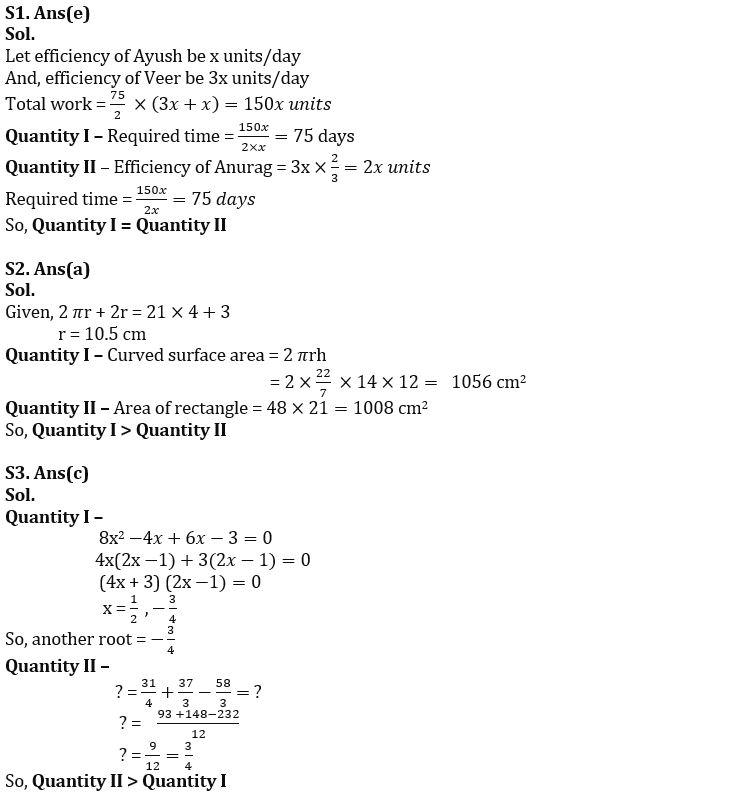
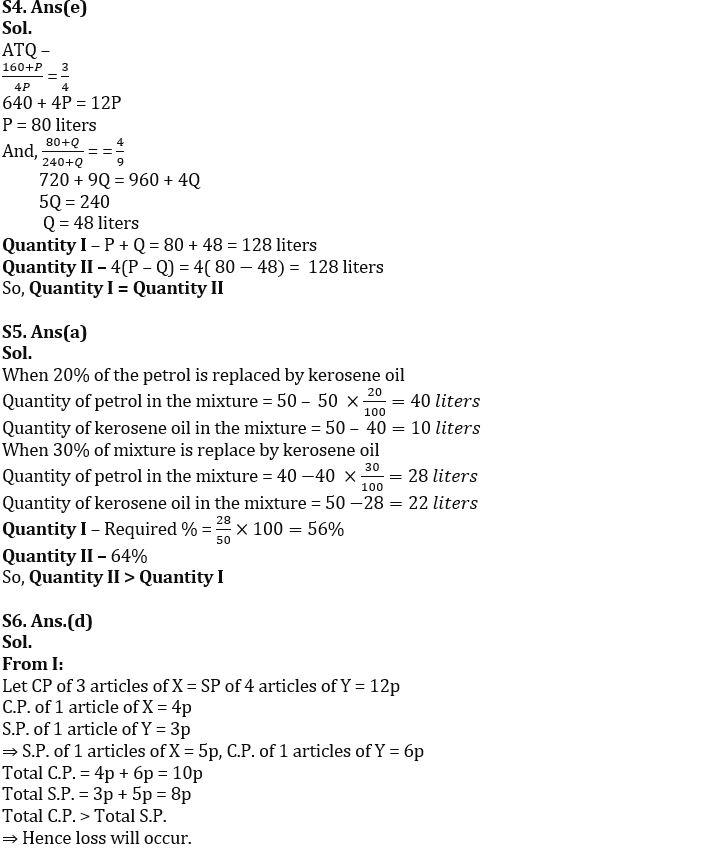
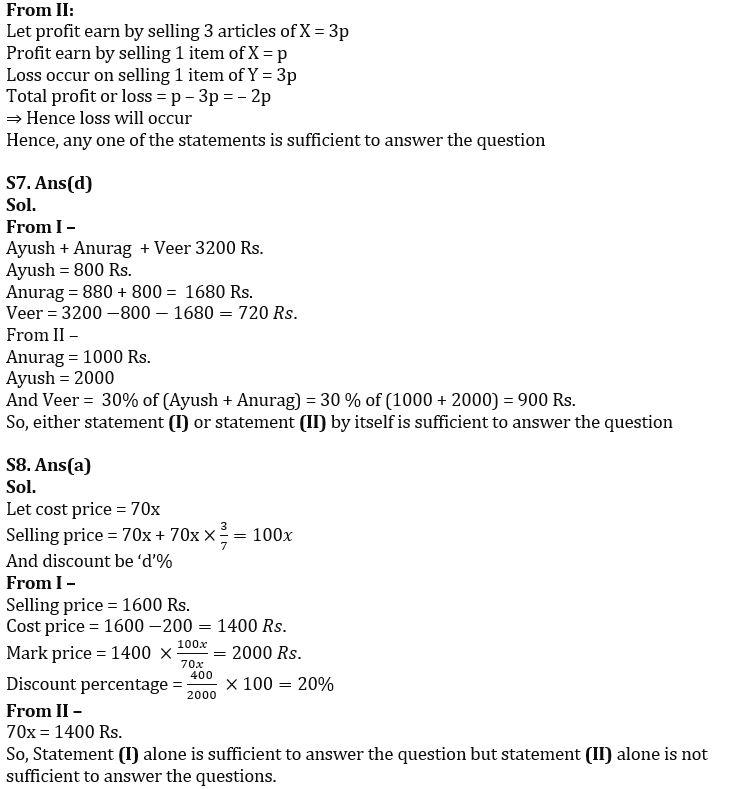
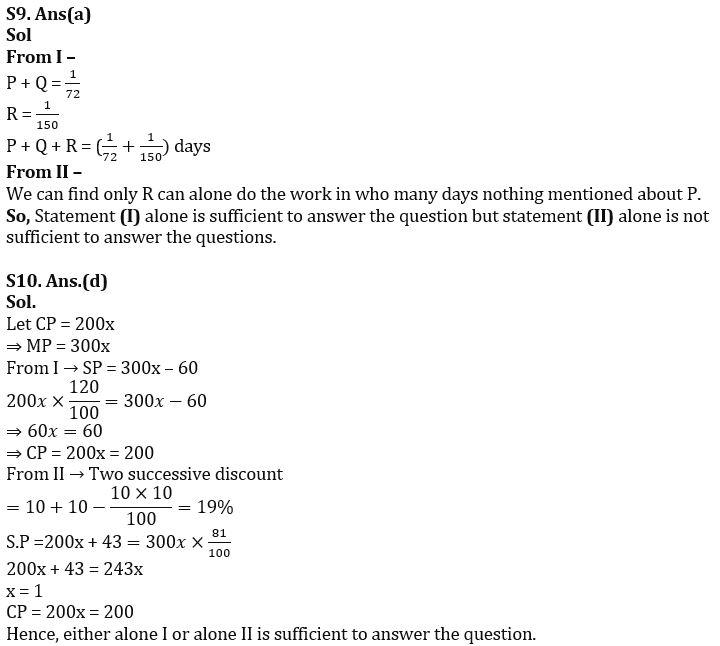
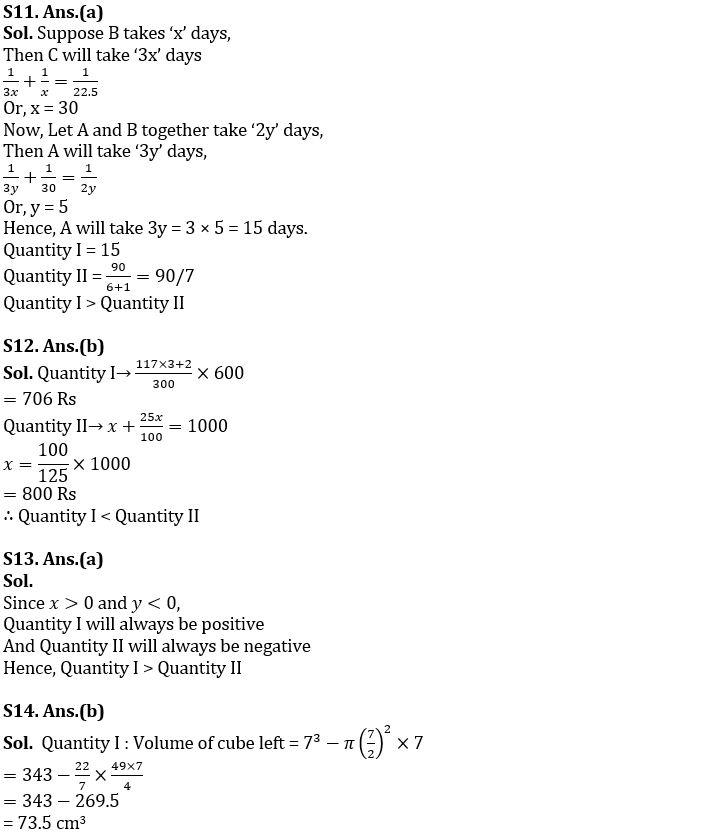
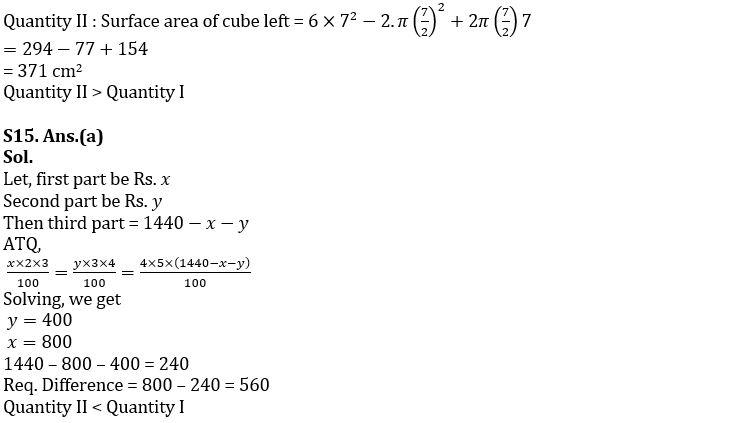


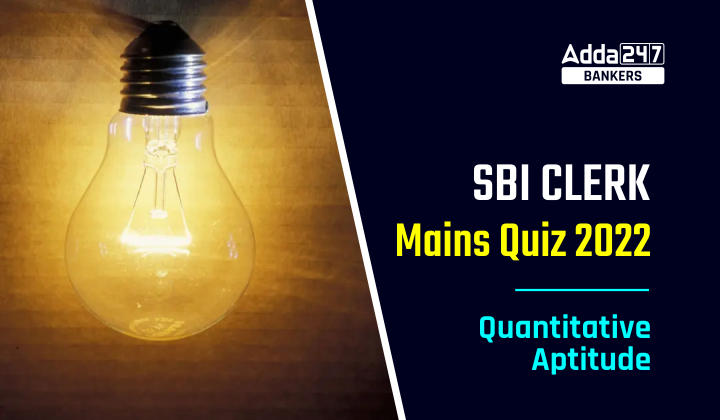
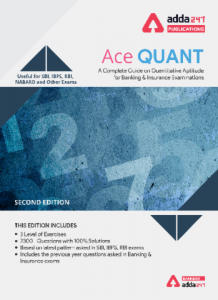
 Quantitative Aptitude Quiz For Bank Main...
Quantitative Aptitude Quiz For Bank Main...
 Quantitative Aptitude Quiz For Bank Foun...
Quantitative Aptitude Quiz For Bank Foun...



